News and Site Updates Archive 2009/10/31
Hardly any human being is capable of pursuing two professions or two arts rightly.
- Plato
31 Oct '09 -

Elizabeth Alexandra Mary otherwise known as Queen Elizabeth II is shown with
Presidents Truman, Eisenhower, Kennedy, Nixon, Ford, Carter, Reagan, G H W Bush, Clinton, G W Bush, Obama.
Actually, Queen Elizabeth has been on the throne during the terms of 12 presidents, though only 11 are shown here. Missing is a photo of her with Lyndon Johnson because I don't think she had her photo
made with him. In fact, I don't think she ever met him. (I read somewhere that she detested him.) Clicking the collage will show a larger version but the individual photos are from
here. In the individual photos, you would be able to see that Queen Elizabeth almost always carries a
purse. She carries it with her throughout the day as she moves from room to room in Buckingham Palace. All tables and her desk at the palace are equipped with special hooks on which she hangs her
purse so that it never sits on the floor. Just what does Queen Elizabeth carry in that
purse? One thing is an S-shaped metal meat hook that she can place on the edge of a piece of furniture to hang her purse on. She always carries a metal make-up case given to her by Prince
Philip as a wedding gift and a collection of good luck charms - mostly gifts from her children - including dogs, horses, saddles, and horsewhips. She has photos of her children, mints, chocolate drops
for her corgi dogs, and a crossword or two snipped from the papers by her attendants. She carries a comb, handkerchief, small gold compact and a tube of lipstick. On Sundays, she carries paper
money to place in the collection plate at church. Her purse also doubles as a signal device - when she doing royal duties at some function, she uses it to communicate with her servants. When she
shifts the bag from one arm to another it means she’s ready to leave. When at a banquet, if she sets her purse on the floor, it’s a bad sign - the conversation is boring and she wants to
escape. However, if the royal bag dangles from the crook of her left arm, she's happy.
  The Empathy Belly® Pregnancy
Simulator lets you know what it feels like to be pregnant! It's a multi-component, weighted garment that will, through medically accurate simulation, enable you to experience over 20 symptoms and effects
of pregnancy, including weight gain of 30 pounds (13.6 kilograms), fœtal kicking and stroking movements, enlarged breasts and protruding abdomen, postural changes of the back with an increase in lordosis
(pelvic tilt), bladder pressure and frequency of urination, low backaches; shift in centre of gravity, increased fatigue and waddling. It makes faking a pregnancy so-o-o easy and
convincing... "It is very easy to see why coloured people should hate us, but why we should hate them is beyond my comprehension. They never sold our wives. They never robbed our
cradles. They never scarred our backs. They never pursued us with bloodhounds. They never branded our flesh. It has been said that it is hard to forgive a man to whom we have done a
great injury. I can conceive of no other reason why we should hate the coloured people. To us they are a standing reproach. Their history is our shame." - Robert Green Ingersoll,
“Civil Rights” (1883) via Cynical-C. Emmett Till, a 14-year old black boy murdered in Mississippi in August 1955
sparked the US Civil Rights movement. Till, visiting Mississippi from Chicago, whistled at a married
white woman thus incurring the wrath of local whites. Till’s body was found swollen and disfigured in a river 3 days after his abduction and only identified by his ring. On the day he was buried,
two men were indicted for his murder, but the 12-member all-white male jury (some of whom actually participated in Till’s torture and execution) took only an hour to return a not guilty verdict. They
said it took that long because the jury paused for a soft drink on the way to the deliberation room. To add insult to injury, the murderers admitted to everything after they were found not guilty,
selling their stories to LOOK magazine for $4,000. The Empathy Belly® Pregnancy
Simulator lets you know what it feels like to be pregnant! It's a multi-component, weighted garment that will, through medically accurate simulation, enable you to experience over 20 symptoms and effects
of pregnancy, including weight gain of 30 pounds (13.6 kilograms), fœtal kicking and stroking movements, enlarged breasts and protruding abdomen, postural changes of the back with an increase in lordosis
(pelvic tilt), bladder pressure and frequency of urination, low backaches; shift in centre of gravity, increased fatigue and waddling. It makes faking a pregnancy so-o-o easy and
convincing... "It is very easy to see why coloured people should hate us, but why we should hate them is beyond my comprehension. They never sold our wives. They never robbed our
cradles. They never scarred our backs. They never pursued us with bloodhounds. They never branded our flesh. It has been said that it is hard to forgive a man to whom we have done a
great injury. I can conceive of no other reason why we should hate the coloured people. To us they are a standing reproach. Their history is our shame." - Robert Green Ingersoll,
“Civil Rights” (1883) via Cynical-C. Emmett Till, a 14-year old black boy murdered in Mississippi in August 1955
sparked the US Civil Rights movement. Till, visiting Mississippi from Chicago, whistled at a married
white woman thus incurring the wrath of local whites. Till’s body was found swollen and disfigured in a river 3 days after his abduction and only identified by his ring. On the day he was buried,
two men were indicted for his murder, but the 12-member all-white male jury (some of whom actually participated in Till’s torture and execution) took only an hour to return a not guilty verdict. They
said it took that long because the jury paused for a soft drink on the way to the deliberation room. To add insult to injury, the murderers admitted to everything after they were found not guilty,
selling their stories to LOOK magazine for $4,000.
You: Hi.
Stranger: Hi.
You: Name?
Stranger: Chun Wu at your service.
You: Alexander Goldberg.
Stranger: S'up?
You: You know, I never forgave you Koreans for attacking Pearl Harbor.
Stranger: Uhhh - I'm Chinese - and that was the Japanese who attacked it.
You: Chinese, Japanese, Korean - What's the difference?
Stranger: ? Are You serious?
You: Yeah.
Stranger: ... You know... I never forgave you Jews for sinking the Titanic.
You: That was an iceberg.
Stranger: Goldberg, Greenberg, iceberg... What's the
difference? |
 |
Hypocrisy oils the wheels: We blame our leaders for making decisions based on what we really
want, not on what we actually say. Oil, trade, employment and money are important to us – and, by us, I mean we the people, not just they the politicians or business interests. What are the issues
over which we citizens of a great liberal democracy have become really, seriously, exercised in the last decade? The environment? Zimbabwe? North Korea? No, the price of petrol, the
recession, the money in our pockets, our jobs. That's what we care about and the politicians know it. When there's a controversial war, some nice, middle-class people go on an organised weekend
stroll. When petrol is too expensive, lorry drivers blockade the major roads and the country grinds to a halt. Our leaders would have to be fools to take the former more seriously than the
latter.
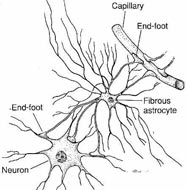 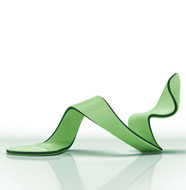 Astrocytes - named for their star-like rays reaching out in
all directions, these are the most abundant of all glial cells and therefore the most abundant of all cells in the brain. They're also the most mysterious - a single astrocyte can wrap its rays around more
than a million synapses (in fact, neurons that grow with astrocytes form nearly 10 times as many synapses as neurons that grow without them). Astrocytes also fuse to each other, building channels through
which molecules shuttle from cell to cell. All those connections put them in a great position to influence the brain; they have receptors that can snag a variety of neurotransmitters, which means they
eavesdrop on biochemical chatter going on around them. Yet for a long time neuroscientists couldn't find any sign that astrocytes responded to outside signals. It turns out, however, that they,
like neurons, can react to neurotransmitters but instead of electricity, they produce waves of charged calcium atoms. The calcium comes from sealed packets scattered throughout each cell; when
stimulated, cells rip open calcium packets in the ray that first senses the neurotransmitters, triggering the opening of other packets elsewhere in the cell. The astrocytes then stash the calcium atoms
back into the packets only to unleash them again when next stimulated. A wave of such activity that starts in one astrocyte can spread to others. And astrocytes themselves sometimes release
powerful neurotransmitters: glutamate (which excites neurons so they're more likely to respond to a signal from another neuron) and adenosine (which blunts neurons' sensitivity). Two different stimulus
signals produce two different patterns of calcium waves (that is, two different responses) in an astrocyte - and when the astrocyte gets both signals at once, the waves it produces isn't just the sum of the
two patterns but an entirely new one (that’s what neurons — and computers, for that matter — do). If astrocytes really process information, that's a major addition to the brain’s computing
power. Instead of the digital code of voltage spikes that neurons use, astrocytes act more like an analogue network, encoding information in slowly rising and falling waves of calcium. Conversations
among astrocytes may be responsible for "our creative and imaginative existence as human beings." Really? I think they may control our
emotions... Mojito shoes by Julian Hakes are created from carbon fibre (with rubber for soles and leather
on the sides). They wrap around the foot, supporting the heel and the ball while the foot acts as a bridge between the two. Julian Hakes
is normally an architect. Astrocytes - named for their star-like rays reaching out in
all directions, these are the most abundant of all glial cells and therefore the most abundant of all cells in the brain. They're also the most mysterious - a single astrocyte can wrap its rays around more
than a million synapses (in fact, neurons that grow with astrocytes form nearly 10 times as many synapses as neurons that grow without them). Astrocytes also fuse to each other, building channels through
which molecules shuttle from cell to cell. All those connections put them in a great position to influence the brain; they have receptors that can snag a variety of neurotransmitters, which means they
eavesdrop on biochemical chatter going on around them. Yet for a long time neuroscientists couldn't find any sign that astrocytes responded to outside signals. It turns out, however, that they,
like neurons, can react to neurotransmitters but instead of electricity, they produce waves of charged calcium atoms. The calcium comes from sealed packets scattered throughout each cell; when
stimulated, cells rip open calcium packets in the ray that first senses the neurotransmitters, triggering the opening of other packets elsewhere in the cell. The astrocytes then stash the calcium atoms
back into the packets only to unleash them again when next stimulated. A wave of such activity that starts in one astrocyte can spread to others. And astrocytes themselves sometimes release
powerful neurotransmitters: glutamate (which excites neurons so they're more likely to respond to a signal from another neuron) and adenosine (which blunts neurons' sensitivity). Two different stimulus
signals produce two different patterns of calcium waves (that is, two different responses) in an astrocyte - and when the astrocyte gets both signals at once, the waves it produces isn't just the sum of the
two patterns but an entirely new one (that’s what neurons — and computers, for that matter — do). If astrocytes really process information, that's a major addition to the brain’s computing
power. Instead of the digital code of voltage spikes that neurons use, astrocytes act more like an analogue network, encoding information in slowly rising and falling waves of calcium. Conversations
among astrocytes may be responsible for "our creative and imaginative existence as human beings." Really? I think they may control our
emotions... Mojito shoes by Julian Hakes are created from carbon fibre (with rubber for soles and leather
on the sides). They wrap around the foot, supporting the heel and the ball while the foot acts as a bridge between the two. Julian Hakes
is normally an architect.
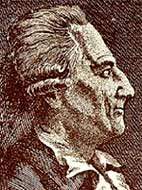 |
 |
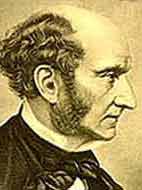 |
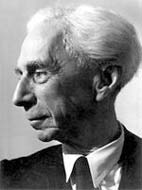 |
|
Giacomo Girolamo Casanova de Seingalt |
Thomas Lawrence Young |
John Stuart Mill |
Bertrand Arthur William Russell, 3rd Earl Russell |
From Casanova: A Study in Self-Portraiture by Stefan Zweig (used here to illustrate why Casanova
was not a proper polymath): "He excelled in mathematics no less than in philosophy. He was a competent theologian, preaching his first sermon in a Venetian church when he was not yet 16 years
old. As a violinist, he earned his daily bread for a whole year in the San Samuele theatre. When he was 18 he became doctor of laws at the University of Padua — though down to the present day the
Casanovists are still disputing whether the degree was genuine or spurious. He was well informed in chemistry, medicine, history, philosophy, literature, and, above all, in the more lucrative (because
perplexing) sciences of astrology and alchemy. As universal dilettante, indeed, he was perfect, knowing an incredible amount of all the arts and all the sciences; but he lacked one thing, and this lack
made it impossible for him to become truly productive. He lacked will, resolution, patience." Thomas
Young, not merely a polymath, was also considered by some to be "The Last Man Who Knew Everything". Young died in 1829. But I was taught in school that John Stuart Mill,
who died in 1873, was the last man who knew everything. Was Mill not considered a polymath, then? Lots of people besides myself think that he was. Mill's godson,
Bertrand Russell, also a polymath, once wrote: "Man is the product of ... the outcome of accidental collocation of atoms ... no
fire, no heroism, no intensity of thought and feeling can preserve an individual life beyond the grave ... all the labours of the age, all the devotion, all the inspiration, all the noonday brightness of human
genius, are destined to extinction in the vast death of the solar system, and ... the whole temple of Man's achievement must inevitably be buried beneath the debris of a universe in ruins - all these things, if
not quite beyond dispute, are yet so nearly certain that no philosophy which rejects them can hope to stand ... I regard [religion] as a disease born of fear and as a source of untold misery to the human
race. I cannot, however, deny that it has made some contributions to civilisation. It helped in early days to fix the calendar and it caused Egyptian priests to chronicle eclipses with such care
that in time they became able to predict them. These two services I am prepared to acknowledge but I do not know of any
others." Russell lived from 1872 to 1970. Though Russell was brilliant, it is no longer possible for one person to know
even a little bit about everything that is known (even Wikipedia falls short). In an age of specialists,
does it matter that generalists no longer thrive? The world is hardly short of knowledge and knowing
about a lot of things has never been easier. Dabblers are free to paddle along the shore and dip into the first rock pool that catches the eye. If you have an urge to take off your shoes and test
the water, countless specialists are ready to hold your hand. And yet you're unlikely to get very deep - depth is for monomaths. Polymaths may have been more prevalent as a percentage of the
population back when there was less to know. The world is a better place for the specialisation that has come along but the choices modern life imposes are more cramped. Innovations often come from
a fresh eye or another discipline because now most scientists are forced to devote their careers to solving the everyday problems in their speciality if they want to ensure financial success. But maybe
collaborations amongst monomaths from different disciplines can lead to the innovation and breakthroughs produced by great polymaths of the past. (Some polymaths do still exist - but, according to H L
Mencken, a society made up of individuals who are all capable of original thought would probably be unendurable.)
The word God is for me nothing more than the expression and product of human weakness,
the Bible a collection of honourable, but still purely primitive, legends which are nevertheless pretty childish.
No interpretation no matter how subtle can (for me) change this.
- Albert Einstein
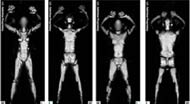 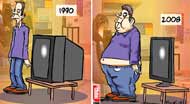 Imagine you're a frequent flier: long years of experience have taught
you all the tips and tricks for a rapid check in. A good thing, right? Actually, in the future it may become cause for suspicion. A European-Union-funded project called ADABTS (Automatic
Detection of Abnormal Behaviour and Threats in Crowded Spaces) is working on ways to detect suspicious behaviour. One system involves a network of cameras in airports that measure your speed and alert
the control room should it seem excessive. The system knows terrorists tend to be nervous and almost never stop for coffee. This makes a speedy traveller a suspicious traveller. You may also
want to think twice about using the airport bathroom more than once as there's a good chance you'll be picked out for an extensive security check... Evolution in action... Painfully honest mobile home
commercial: that's how they do things in Alabama?... A collection of funny blunders from BBC newsreaders (less than 5 minutes
and it may make you laugh)... "...and that's how I ended up in the wardrobe": never underestimate the power of a great
story! Via Cynical-C... What do Mao Zedong and Howard Hughes have in common? In maturity, especially later in life,
neither one brushed his teeth. Ever. Hughes — inventor of one of the largest planes in history, owner of Trans-World
Airlines, blockbusting director, millionaire (for a while the world’s wealthiest man), and aviation pioneer (a transcontinental airspeed record-holder) — was also a lifelong obsessive-compulsive
germaphobe. His aversion to the toothbrush stemmed from its ability to carry invisible contaminants. The mastermind of China’s Communist revolution and the author of the Little Red Book, on
the other hand, simply preferred not to brush. Instead, Chairman Mao rubbed his teeth with green tea leaves, giving them a well-documented jade tinge. "A tiger," he reasoned, "never brushes his
teeth." According to The Book of Odds, 78% of American adults
brush their teeth at least twice a day or even after every meal. (But I find that highly unlikely.) Imagine you're a frequent flier: long years of experience have taught
you all the tips and tricks for a rapid check in. A good thing, right? Actually, in the future it may become cause for suspicion. A European-Union-funded project called ADABTS (Automatic
Detection of Abnormal Behaviour and Threats in Crowded Spaces) is working on ways to detect suspicious behaviour. One system involves a network of cameras in airports that measure your speed and alert
the control room should it seem excessive. The system knows terrorists tend to be nervous and almost never stop for coffee. This makes a speedy traveller a suspicious traveller. You may also
want to think twice about using the airport bathroom more than once as there's a good chance you'll be picked out for an extensive security check... Evolution in action... Painfully honest mobile home
commercial: that's how they do things in Alabama?... A collection of funny blunders from BBC newsreaders (less than 5 minutes
and it may make you laugh)... "...and that's how I ended up in the wardrobe": never underestimate the power of a great
story! Via Cynical-C... What do Mao Zedong and Howard Hughes have in common? In maturity, especially later in life,
neither one brushed his teeth. Ever. Hughes — inventor of one of the largest planes in history, owner of Trans-World
Airlines, blockbusting director, millionaire (for a while the world’s wealthiest man), and aviation pioneer (a transcontinental airspeed record-holder) — was also a lifelong obsessive-compulsive
germaphobe. His aversion to the toothbrush stemmed from its ability to carry invisible contaminants. The mastermind of China’s Communist revolution and the author of the Little Red Book, on
the other hand, simply preferred not to brush. Instead, Chairman Mao rubbed his teeth with green tea leaves, giving them a well-documented jade tinge. "A tiger," he reasoned, "never brushes his
teeth." According to The Book of Odds, 78% of American adults
brush their teeth at least twice a day or even after every meal. (But I find that highly unlikely.)
 |
 |
| The San Francisco-Oakland Bay Bridge has been closed indefinitely
after a rod installed during September's emergency repairs snapped, causing a traffic nightmare for the 26,000 motorists who cross it daily (the caption for the photo shown says 280,000 motorists cross
it every day - a slight difference and a more realistic figure, I think). The bridge was closed over the Labor Day holiday weekend while long-planned earthquake safety upgrades were
made. When the crack was discovered, state transportation officials initially feared it would prevent them from reopening the span in time for the start of the work week - but the unexpected work
only ended up taking a few extra hours. A rod held in place a saddle-like cap installed over the cracked link. But then that rod broke (during rush hour) and brought down with it a steel
patch roughly 3 feet long weighing 5,000 pounds. Three vehicles were damaged but there were fortunately no injuries. Abolhassan Astaneh-Asl, a civil engineering professor at the University
of California, Berkeley has spent 20 years studying the Bay Bridge. He called the initial crack a "warning sign" of potentially bigger safety issues. "The repair they were doing was really
a Band-Aid," he said, "and the Band-Aid broke." Astaneh-Asl said the failure of the repair job demonstrates the need for a longer-term solution. The bridge's age and design make it susceptible to
collapse, especially if commercial tractor-trailers are allowed to continue using it. "I think Caltrans is putting public relations ahead of public safety." |
Biochemist Mark Roth discovered that if you cut off certain creatures’ oxygen supply in just the right way, they won’t
die. Instead, they’ll fall into a kind of suspended animation, or hibernation. They wont take a breath. Their hearts won’t beat. Wounds stop bleeding; nearly any injury becomes
survivable, and the brain shuts down without damage. "If you were shot, this is exactly what you would want," Roth says. And when the wounds are bound up, the critters can be brought back, good as
new. All that’s needed is a whiff of a hydrogen sulphide, which binds to mitochondria and impedes the body’s ability to use oxygen.
Some Christian lawyers, some eminent and stupid judges have said and still say, that the Ten Commandments are the foundation of all law.
Nothing could be more absurd; long before these commandments were given there were codes of laws in India and Egypt - laws against murder, perjury, larceny, adultery and fraud.
Such laws are as old as human society; as old as the love of life; as old as industry; as the idea of prosperity; as old as human love.
All of the Ten Commandments that are good were old; all that were new are foolish.
If Jehovah had been civilised he would have left out the commandment about keeping the Sabbath, and in its place would have said: "Thou shalt not enslave thy fellow-men."
He would have omitted the one about swearing, and said: "The man shall have but one wife, and the woman but one husband."
He would have left out the one about graven images, and in its stead would have said: "Thou shalt not wage wars of extermination, and shalt not unsheathe the sword except in self-defence."
If Jehovah had been civilised, how much grander the Ten Commandments would have been!
- Robert Green Ingersoll, About the Holy Bible (1894) via Cynical-C
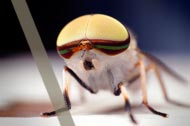  Male Striped
Horse Fly (Tabanus lineola): "It's really a beautiful fly. Through the viewfinder I watched him make several bizarre movements with his front legs, totally different than any other fly I have
seen. He was on a white painted railing which bounced the flash back up and provided some nice lighting." Taken from The Incredible
Macro Bug Portraiture of Thomas Shahan. To me, this bug looks like he's a 16-year-old about to hop on his motorcycle... From a review of the book,
Does God Hate Women? by Ophelia Benson and Jeremy Stangroom: "Multiculturalism by definition makes a
fetish of cultures, and it is almost impossible to do that without treating them as monolithic. As soon as you admit that all cultures have internal dissent and nonconformity, the whole idea of
protecting or deferring to particular cultures breaks down into incoherence." Apologists for religion say that misogynists are simply misinterpreting the holy texts, which are in fact about love and
compassion and kindness. But this is certainly not the God of the texts who orders his followers to commit mass murder, including of women and children, and explicitly says women are inferior
beings. In order to defend their God, apologists often have to lie about what He and His Prophets "say" in the texts. Cherie Blair, for example, claimed in a lecture: "It is not laid down in the
Quran that women can be beaten by their husbands." But it quite plainly is. The Quran says: "If you fear high-handedness from your wives, remind them [of the teachings of God], then ignore them
when you go to bed, then hit them." There are people in all religions who have – through theological contortions – managed to leave behind literal readings of the text and invent a less foul God to
believe in. It is not for atheists to say that one group of believers is right and the other is wrong, as we think they’re all wrong. Male Striped
Horse Fly (Tabanus lineola): "It's really a beautiful fly. Through the viewfinder I watched him make several bizarre movements with his front legs, totally different than any other fly I have
seen. He was on a white painted railing which bounced the flash back up and provided some nice lighting." Taken from The Incredible
Macro Bug Portraiture of Thomas Shahan. To me, this bug looks like he's a 16-year-old about to hop on his motorcycle... From a review of the book,
Does God Hate Women? by Ophelia Benson and Jeremy Stangroom: "Multiculturalism by definition makes a
fetish of cultures, and it is almost impossible to do that without treating them as monolithic. As soon as you admit that all cultures have internal dissent and nonconformity, the whole idea of
protecting or deferring to particular cultures breaks down into incoherence." Apologists for religion say that misogynists are simply misinterpreting the holy texts, which are in fact about love and
compassion and kindness. But this is certainly not the God of the texts who orders his followers to commit mass murder, including of women and children, and explicitly says women are inferior
beings. In order to defend their God, apologists often have to lie about what He and His Prophets "say" in the texts. Cherie Blair, for example, claimed in a lecture: "It is not laid down in the
Quran that women can be beaten by their husbands." But it quite plainly is. The Quran says: "If you fear high-handedness from your wives, remind them [of the teachings of God], then ignore them
when you go to bed, then hit them." There are people in all religions who have – through theological contortions – managed to leave behind literal readings of the text and invent a less foul God to
believe in. It is not for atheists to say that one group of believers is right and the other is wrong, as we think they’re all wrong.

The Highway of Death
It's called the Highway of Death because it's littered with burned tanks, trucks, cars and the corpses of
defeated Iraqi soldiers who attempted to flee Kuwait. At the end of February, 1991, Iraqi military personnel and civilians retreating from Kuwait were attacked and destroyed by American aircraft and
ground forces during the United Nations Coalition offensive. Saudi and American soldiers then pried open car trunks and took what loot they could carry - mainly ammunition and
weapons. The use of force was disproportionate and the retreating forces included hostages and
refugees. The scenes of carnage on the road were viewed by the international community as a turkey shoot. Human rights groups cite the attack as a war crime of great magnitude — the deliberate
bombing of a stretch of highway where fleeing Iraqi soldiers were stuck in a frenzied traffic jam. The US, however, maintains that few Iraqi soldiers were found in the wreckage. (And this somehow
makes their action better?) Graham Greene writes in The Quiet American, a fictional
narrative about the Viet Nam war still relevant today: "Impregnably armoured by his good intentions and his ignorance," Alden Pyle [seemingly a young, polite, modest, boyish new economic attaché - but really a
covert CIA agent] embodies all that protagonist Thomas Fowler (and Greene) can’t stand about Americans: too much money, too much confidence, and too little self-awareness. Cruising the streets of Saigon
in oversized Buicks, air conditioning everything in sight (to Fowler’s dismay, even the US legation’s lavatories), passing out cigarettes as if they exist in infinite supply, and quoting York Harding, zealots
like Pyle proceed on the assumption that American know-how backed by American values can make short work of even the most perplexing difficulties. Born and raised a Unitarian, Pyle takes God’s existence
as a given, his faith reinforcing his conviction that America’s purposes necessarily reflect God’s will. Is Pyle as naïve as he appears? Are his professions of high ideals real or
contrived? Does he take seriously the verities offered by York Harding in books like The Challenge to Democracy and The Role of the West? Or does he merely appropriate them to lend
a veneer of respectability to a ruthless enterprise? When Pyle prattles on about freedom and democracy, does he mean what he says or is it just so much cant? Although Greene poses these
questions — which by implication apply not only to Pyle but to the nation and the cause that Pyle serves - he refrains from offering explicit answers. Indeed, Greene suggests that the answers may not
really matter. "Innocence," he writes, "is a kind of insanity." To press the point further, the statesman who assumes that "we" are good while "they" are evil — think George W Bush in the wake of
9/11 — will almost necessarily misinterpret the problem at hand and underestimate the complexity and costs entailed in trying to solve it. In this sense, an awareness of one’s own failings and foibles
not only contributes to moral clarity but can help guard against strategic folly. Those who conceived the Iraq War, the cheerleaders who promoted it from the sidelines, and critics of that war who have
now succeeded to positions of power share a common interest in wiping the slate clean, refurbishing the claim that the US meant well because they always mean well. No doubt mistakes were made. Yet
America’s benign intentions expiate sins committed along the way — or allow those in authority to assign responsibility for any sins to soldiers who in doing Washington’s bidding became sources of
embarrassment (think Abu Ghraib). Some things just never change.
 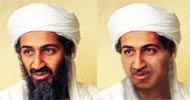 Sporting a moustache may improve your chances of landing a higher-paying job, but it won’t mean
you put more money in the bank, according to a study commissioned by Quicken® and the American Mustache Institute (AMI), a St Louis-based think tank and advocacy organisation representing moustached
Americans. The study examined a random sample of 2,000 moustached Americans along with 2,000 bearded and 2,000 clean-shaven Americans, finding that moustached Americans earn 8.2% more on average than
those with beards and 4.3% more than the clean-shaven. However, they also tended to spend 11% more and save 3% less than their collective counterparts. On the other hand, here are photos of 7 famous people without their trademark facial hair. My conclusion? They all look much
younger without... Kenyan Simon Sawe was leading countryman David Tuwei by 10 seconds in the Des Moines Marathon when, after a left turn onto the final stretch on Southwest Fourth, he stared right at a train crossing the road. "Nobody is prepared for that scenario," said Sawe, who won the
inaugural marathon in 2002. "I couldn't believe it. It was a long train." Tuwei caught the 40-year-old Sawe and the two waited ... and waited ... and waited for the train to
pass. Third-place Geoffrey Birgen had nearly caught the two leaders when the train finally cleared the street about 40 to 50 seconds later. The 26.2-mile race then came down to a 400-meter
sprint... Twelve million-dollar questions from "Who Wants to Be a Millionaire?" that won 12 lucky people a total of
$13,040,000 (or 20,000,000 rupees)... "You've saved 6 billion lives! But you must never tell anyone. This medal will
have to suffice." (Thanks, Stefan.) Sporting a moustache may improve your chances of landing a higher-paying job, but it won’t mean
you put more money in the bank, according to a study commissioned by Quicken® and the American Mustache Institute (AMI), a St Louis-based think tank and advocacy organisation representing moustached
Americans. The study examined a random sample of 2,000 moustached Americans along with 2,000 bearded and 2,000 clean-shaven Americans, finding that moustached Americans earn 8.2% more on average than
those with beards and 4.3% more than the clean-shaven. However, they also tended to spend 11% more and save 3% less than their collective counterparts. On the other hand, here are photos of 7 famous people without their trademark facial hair. My conclusion? They all look much
younger without... Kenyan Simon Sawe was leading countryman David Tuwei by 10 seconds in the Des Moines Marathon when, after a left turn onto the final stretch on Southwest Fourth, he stared right at a train crossing the road. "Nobody is prepared for that scenario," said Sawe, who won the
inaugural marathon in 2002. "I couldn't believe it. It was a long train." Tuwei caught the 40-year-old Sawe and the two waited ... and waited ... and waited for the train to
pass. Third-place Geoffrey Birgen had nearly caught the two leaders when the train finally cleared the street about 40 to 50 seconds later. The 26.2-mile race then came down to a 400-meter
sprint... Twelve million-dollar questions from "Who Wants to Be a Millionaire?" that won 12 lucky people a total of
$13,040,000 (or 20,000,000 rupees)... "You've saved 6 billion lives! But you must never tell anyone. This medal will
have to suffice." (Thanks, Stefan.)
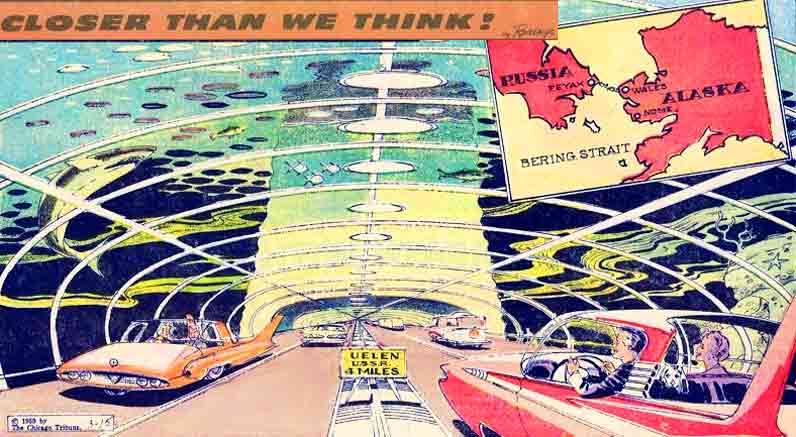
Highway to Russia: Senator Magnuson of Washington has a bold new idea for linking our newest state, Alaska, with Siberia via a
bridge or vehicular tunnel across the 30 to 40 mile stretch of shallow waters of the Bering Strait. It would go from Wales on the
tip of Seward Peninsula, to Little Diomede and Big Diomede Islands, thence to Peyak, Siberia. The Senator forecasts this hookup
within the lifetime of the present generation, creating a rail and highway route between points as distant as New York and Paris.
"I am convinced," he says, "that the tourists who one day will drive this route will be our best ambassadors!"
The 3 March 1959 edition of Arthur Radebaugh's "Closer Than We Think" depicts a highway to Russia, as
imagined by Senator Warren G Magnuson. According to Wikipedia, this was not a new idea. Joseph Strauss, designer of
the Golden Gate Bridge, proposed something similar for railroads in the 1890s... I found these pages to be a bit slow loading but
fascinating - the photographer focuses on a suburban-tract-home neighbourhood located in Santa Clara, California built during the 1950’s from the same architectural plan. She shows in 13 photos how
people have individualised their homes to rebel against conformity and display their personalities (via Conscientious).
  Dorothy was a kind and giving soul. Those of us who loved her, enjoyed many hours being groomed by her. Her long lovely
fingers were patient and unwavering in their gentleness; only seldom did she bow her head and look up sweetly, asking for someone to groom her in reciprocation. I trusted her completely, and for some
inexplicable reason, considering the harm done to her by humans, she knew that she could trust us. We buried Dorothy beside the enclosure where she lived and beside the tomb of her friend
Becky. All the chimpanzees in her family came to watch and mourn with us. When we brought her to the grave site, they asked to see her again, so I took her body close for them to see her a final
time. None of them left until the burial was finished (via Pharyngula)... A litter of pigs born in
Yinken, central China have no external snouts. Their snouts are actually inside their mouths, though I'm unsure how they are able to breathe while they eat. Apparently this is the result of a rare
genetic mutation and it's unknown at this point if the trait will pass to offspring. Not mentioned in the article, though it seems to me to be equally, if not more, important, is the fact that these pigs
have lips... Critics of zoos usually compare them to prisons. Ralph R Acampora, an associate professor of philosophy at
Hofstra University, thinks zoo confinement is closer to pornography. "Both participants in pornography and inhabitants of zoos are slaves to other people’s desire for viewing, for sight," he
explains. All "have their real nature concealed through their exposure," with zoo animals "reduced to their shapes or colours or stereotypical behaviours." Dorothy was a kind and giving soul. Those of us who loved her, enjoyed many hours being groomed by her. Her long lovely
fingers were patient and unwavering in their gentleness; only seldom did she bow her head and look up sweetly, asking for someone to groom her in reciprocation. I trusted her completely, and for some
inexplicable reason, considering the harm done to her by humans, she knew that she could trust us. We buried Dorothy beside the enclosure where she lived and beside the tomb of her friend
Becky. All the chimpanzees in her family came to watch and mourn with us. When we brought her to the grave site, they asked to see her again, so I took her body close for them to see her a final
time. None of them left until the burial was finished (via Pharyngula)... A litter of pigs born in
Yinken, central China have no external snouts. Their snouts are actually inside their mouths, though I'm unsure how they are able to breathe while they eat. Apparently this is the result of a rare
genetic mutation and it's unknown at this point if the trait will pass to offspring. Not mentioned in the article, though it seems to me to be equally, if not more, important, is the fact that these pigs
have lips... Critics of zoos usually compare them to prisons. Ralph R Acampora, an associate professor of philosophy at
Hofstra University, thinks zoo confinement is closer to pornography. "Both participants in pornography and inhabitants of zoos are slaves to other people’s desire for viewing, for sight," he
explains. All "have their real nature concealed through their exposure," with zoo animals "reduced to their shapes or colours or stereotypical behaviours."
 |
As for the nature of a whale’s inner life, it’s difficult to say but possible to speculate. "My strong suspicion is that a lot of sperm whale life revolves around social issues," said Whitehead. "They’re nomadic, live in permanent groups, and are
dependent on each other for everything. Social structure is vital to them. The only constant thing in their world is their social group. I’d guess that a lot of their life is paying
attention to social relationships." These relationships would be "interestingly different from ours, for a variety of reasons. There’s nowhere to hide, they can use sound to form an image
of each other’s insides — whether you’re pregnant, hungry, sick. In a 3-dimensional habitat, it’s probably much harder to say something is mine, or yours, whether it’s a piece of food or a
potential mate."
Wow. Imagine how different our society would be if humans could do that! |
Born in London, Jane Goodall was fascinated by the natural world from an early age. At 23, she moved to East
Africa — first Kenya, then Tanzania — and found work as assistant to the great palæontologist Louis Leakey. Despite her lack of formal training, Leakey sensed her deep love of animals and encouraged
her to begin a study of the chimpanzees around Lake Tanganyika, in northern Tanzania. In 1964, Goodall married a Dutch wildlife photographer, Baron Hugo van Lawick, who documented many of her
interactions with her subjects. The next year, she obtained a PhD in ethnology from Cambridge at Leakey’s urging and later taught at Stanford University. Her work caused her to risk plane crashes,
malaria, hardships, rivers full of crocodiles, but the worst was the 1975 kidnapping of 4 of her Cambridge/Stanford students in Tanzania by the rebels from Congo coming over the lake. Goodall agreed
with the Tanzanian officials who refused to negotiate their return, noting that a ransom would only embolden the terrorists. Finally, a release agreement was reached (the details vary), but upon her
return to Stanford, Goodall discovered that the kidnapping incident was far from over. Critics suggested that she should have taken her students’ place. She was asked to leave the
university until the controversy had passed. In Africa, her grants were denied.
  Drug companies have sold $1.5 billion worth of swine flu shots, in addition to the $1 billion for
seasonal flu they booked earlier this year. These inoculations are part of a much wider and rapidly growing $20 billion global vaccine market. "The vaccine market is booming. It's a growth area for pharmaceuticals at a
time when other areas are not doing so well." As always with pandemic flu, taxpayers are paying the bill for the 250 million swine flu vaccines that the government has ordered so far and will be
distributing free to doctors, pharmacies and schools. In addition, Congress has set aside more than $10 billion to research flu viruses, monitor H1N1's progress and educate the public about
prevention. Drugmakers pocket most of the revenues from flu sales... I saw an article with the headline "Swine Flu Cases Overestimated?" which was subtitled, "H1N1 Not As Prevalent As Feared". To my surprise, the
article was intended to encourage even those folks who thought they had had swine flu already and were thus now immune to get vaccinated anyway because they probably had normal flu - or didn't really have flu
at all. According to the Centers for Disease Control and Prevention and Wikipedia 5 - 20% of the population gets the flu each year (that's 15 - 60 million people in the US); about 36,000 Americans die each year from
seasonal flu-related causes (250,000 - 500,000 die annually world-wide) and more than 200,000 people are hospitalised. About 1,500 people have died of swine flu in the US thus far and there have been
20,000+ hospitalisations. According to the "Report to the President on US Preparations for 2009 - H1N1
Influenza” by the President’s Council of Advisors on Science and Technology, a plausible scenario is that the epidemic could produce infection of 30 – 50% of the US population this fall and winter with 60
million or so seeking medical attention. As many as 1.8 million could be hospitalised with 30,000 - 90,000 deaths. Unfortunately, it's possible the vaccine may not be ready in time. Or it
may, and few people get the flu. Or maybe no more than usual would have got it anyway. How can you know? Something about this reminds me of Y2K... It may take practice to learn to
read this one-handed clock at a glance. Still, I like it. The time shown is 1:43:03 (via Tywkiwdbi). Drug companies have sold $1.5 billion worth of swine flu shots, in addition to the $1 billion for
seasonal flu they booked earlier this year. These inoculations are part of a much wider and rapidly growing $20 billion global vaccine market. "The vaccine market is booming. It's a growth area for pharmaceuticals at a
time when other areas are not doing so well." As always with pandemic flu, taxpayers are paying the bill for the 250 million swine flu vaccines that the government has ordered so far and will be
distributing free to doctors, pharmacies and schools. In addition, Congress has set aside more than $10 billion to research flu viruses, monitor H1N1's progress and educate the public about
prevention. Drugmakers pocket most of the revenues from flu sales... I saw an article with the headline "Swine Flu Cases Overestimated?" which was subtitled, "H1N1 Not As Prevalent As Feared". To my surprise, the
article was intended to encourage even those folks who thought they had had swine flu already and were thus now immune to get vaccinated anyway because they probably had normal flu - or didn't really have flu
at all. According to the Centers for Disease Control and Prevention and Wikipedia 5 - 20% of the population gets the flu each year (that's 15 - 60 million people in the US); about 36,000 Americans die each year from
seasonal flu-related causes (250,000 - 500,000 die annually world-wide) and more than 200,000 people are hospitalised. About 1,500 people have died of swine flu in the US thus far and there have been
20,000+ hospitalisations. According to the "Report to the President on US Preparations for 2009 - H1N1
Influenza” by the President’s Council of Advisors on Science and Technology, a plausible scenario is that the epidemic could produce infection of 30 – 50% of the US population this fall and winter with 60
million or so seeking medical attention. As many as 1.8 million could be hospitalised with 30,000 - 90,000 deaths. Unfortunately, it's possible the vaccine may not be ready in time. Or it
may, and few people get the flu. Or maybe no more than usual would have got it anyway. How can you know? Something about this reminds me of Y2K... It may take practice to learn to
read this one-handed clock at a glance. Still, I like it. The time shown is 1:43:03 (via Tywkiwdbi).
When the Prophet Muhammad died unexpectedly after a brief illness in Medina (present-day Saudi Arabia) on 8 June 632, his followers were stunned. A contemporary called it "the greatest of
calamities." Their grief was not only for the loss of an irreplaceable leader (Muhammad was "the seal of the prophets" - the last in a line that stretched back to Adam who had received revelations as
"God's emissary" for some 20 years), but he had not unambiguously named his successor. The question of succession would haunt Islam for centuries to come. The wrangling began within hours of
Muhammad's death and led to a momentous rift between two implacable factions, Shia and Sunni - a divide
that continues to this day, often with horrific consequences. Those who supported Muhammad's cousin and son-in-law Ali found themselves pitted against those who favoured Abu Bakr, the Prophet's
closest friend and father-in-law: Abu Bakr's daughter Aisha was Muhammad's 3rd (and favourite, wife) and a force to reckon with in her own right. Ali's supporters formed the "shi'at Ali," the "party of
Ali," from which the term Shia derives. The partisans of Abu Bakr would come to be known as "Sunni" Muslims — those who follow the "sunna," the code of pious practice based on the Prophet's example.

But You Have to Be High to See It: Jason Hawkes, an aerial
photographer, recently completed
a shoot over Las Vegas at night. The images are beautiful but really emphasise just how much
power is consumed keeping those businesses lit at night - so that people don't have to get
outside in the heat of the desert day to spend their money.
Nasal sebum, also known as nose grease/oil, is grease removed from the surface of the human nose. The pores of the lateral creases
(where the nose joins the face) of the exterior of the nose create and store more oil and grease than pores elsewhere on the human body, forming a readily available source of small quantities of grease or
oil. The grease is a particularly oily form of sebum, thought to contain more squalene (C30H50) than the secretions from other parts of the skin. It is notable because nose grease is a convenient
durable lubricant with additional surprising applications - like reducing skipping in scratched CDs and lubricating strings while playing the banjo (via J-Walk Blog).
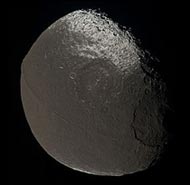  Iapetus is the 3rd-largest moon of Saturn, and 11th in the solar system. Discovered by Giovanni Domenico
Cassini in 1671, Iapetus is best known for its dramatic 2-tone colouration, but recent discoveries by the Cassini mission have revealed several other unusual physical characteristics, such as an
equatorial ridge that runs about halfway around. The ridge stands about 12 miles tall and is in a perfect
straight line. Iapetus also has something that looks like a round water tower - except it's more than a mile high. Oh - and the craters on that moon have geometric shapes, they aren't just
round. One side of Iapetus is turning progressively whiter, just as the other half is becoming
darker. There is a so-called thermal segregation theory to explain this. It suggests that the dark side of Iapetus, by absorbing more sunlight, is able to warm sufficiently to cause local water
ice to evaporate. The vapour then circulates to condense on the nearest cold spot, on the icy, bright side of the moon. As a result, the dark side loses its surface ice thus becoming darker, while
the bright side accumulates ice, and gets brighter... Cahokia was once the greatest biggest city north of
Mexico. Although the Cahokians left no written records, we now know that at its peak in the 12th century, this settlement along the Mississippi River bottomland of western Illinois, a few miles east
of modern-day St Louis, was probably larger than London, and held economic, cultural and religious sway over a vast swath of the American heartland. Featuring a man-made central plaza covering 50 acres
and the 3rd-largest pyramid in the New World (the 100-foot-tall "Monks Mound"), Cahokia was home to at least 20,000 Native Americans. If that doesn't sound impressive from a 21st-century perspective,
consider that the next city on US territory to attain that size would be Philadelphia, some 600 years later. Cahokians performed human sacrifice as part of a theatrical, community-wide
ceremony on a startlingly large scale unknown in North America above the valley of Mexico. Simultaneous burials of as many as 53 young women (quite possibly selected for their beauty) have been uncovered
beneath Cahokia's mounds, and in some cases victims were evidently clubbed to death on the edge of a burial pit and then fell into it. A few of these weren't dead when they went into the pit as skeletons
have been found with their finger bones digging into the layer of sand beneath them. Iapetus is the 3rd-largest moon of Saturn, and 11th in the solar system. Discovered by Giovanni Domenico
Cassini in 1671, Iapetus is best known for its dramatic 2-tone colouration, but recent discoveries by the Cassini mission have revealed several other unusual physical characteristics, such as an
equatorial ridge that runs about halfway around. The ridge stands about 12 miles tall and is in a perfect
straight line. Iapetus also has something that looks like a round water tower - except it's more than a mile high. Oh - and the craters on that moon have geometric shapes, they aren't just
round. One side of Iapetus is turning progressively whiter, just as the other half is becoming
darker. There is a so-called thermal segregation theory to explain this. It suggests that the dark side of Iapetus, by absorbing more sunlight, is able to warm sufficiently to cause local water
ice to evaporate. The vapour then circulates to condense on the nearest cold spot, on the icy, bright side of the moon. As a result, the dark side loses its surface ice thus becoming darker, while
the bright side accumulates ice, and gets brighter... Cahokia was once the greatest biggest city north of
Mexico. Although the Cahokians left no written records, we now know that at its peak in the 12th century, this settlement along the Mississippi River bottomland of western Illinois, a few miles east
of modern-day St Louis, was probably larger than London, and held economic, cultural and religious sway over a vast swath of the American heartland. Featuring a man-made central plaza covering 50 acres
and the 3rd-largest pyramid in the New World (the 100-foot-tall "Monks Mound"), Cahokia was home to at least 20,000 Native Americans. If that doesn't sound impressive from a 21st-century perspective,
consider that the next city on US territory to attain that size would be Philadelphia, some 600 years later. Cahokians performed human sacrifice as part of a theatrical, community-wide
ceremony on a startlingly large scale unknown in North America above the valley of Mexico. Simultaneous burials of as many as 53 young women (quite possibly selected for their beauty) have been uncovered
beneath Cahokia's mounds, and in some cases victims were evidently clubbed to death on the edge of a burial pit and then fell into it. A few of these weren't dead when they went into the pit as skeletons
have been found with their finger bones digging into the layer of sand beneath them.
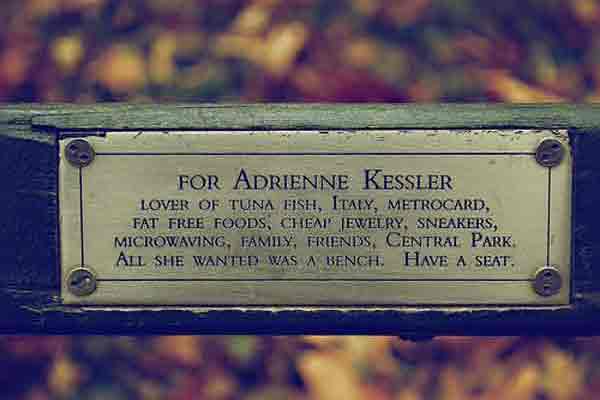
A memorial plaque on a bench.
Hundreds of deer in Austria were discovered either dead or so badly injured they had to be put down by wildlife experts. In the country's rural Salzburg province, 90% of pheasants and 80% of hares were
killed in hail storms. Sepp
Eder, the hunting chief (hunting chief?) said: "Animals sought shelter in farms, in fields of grain but the hail was so heavy it smashed right into them. It may take 5 years for animal numbers to recover, if they
ever do." Farmers are believed to have suffered more than £60 million in damages to crops and buildings. Via Tywkiwdbi... Famous, infamous and iconic photos - I went there to
see one photo and ended up looking at every single one over the course of 2 - 3 days... A slider scales you
downward from a coffee bean through seeds and grains, single-celled animals, various types of cells, viruses, cell components, to water and finally a single carbon atom.
  Louis XIV set her up in Versailles. Napoleon moved her into his
bedroom. She was Italian, created by Leonardo da Vinci over 4 years’ labour in Florence, but France was her home and there she stayed for 400 years. Then on 20 August 1911, the space she occupied
on the walls of the Louvre was discovered bare. The theft shook France: the country’s borders were closed, administrators at the museum were dismissed, enemies of traditional art were suspected of evil
intentions. As months went by, fears grew that the Mona Lisa had been destroyed. Then the Louvre received word from the Uffizi Gallery in Florence. Italian officials said they had arrested a
man named Vincenzo Perugia, who had brought the Mona Lisa to a local antiques dealer in order to sell it and restore it to Italy. On 4 January 1914, the painting was returned to the Louvre. Hailed
as a patriot in Italy, Perugia, while found guilty, served only a few months in jail. Patriotism is a refuge for art thieves... Johan Lorbeer is a German street performer who is famous for defying gravity to achieve apparently impossible
positions for hours at a time. He interacts with his bewildered and irritated audience, whose appetite for communication rises as time goes by. He's shown here at Madrid’s Atocha train station, 10
February 2009... The global ocean on Jupiter’s moon Europa contains about twice the liquid water of all the Earth’s oceans combined. New research suggests that there may be
plenty of oxygen available in that ocean to support life, a hundred times more oxygen than previously estimated... Unfolded,
each cell's genome (strands of DNA) would be approximately 2 metres in length... Time To Eat The Dog: The Real Guide To Sustainable Living says that a medium-sized dog has the same carbon impact
as a Toyota Land Cruiser driven 6,000 miles a year. It also suggests a cat is equivalent to running a Volkswagen Golf. These findings are based on the amount of land needed to grow food for
pets... According to wildlife biologist Lynn Rogers, who has logged thousands of hours
studying North America's black bears, contrary to popular belief, bears are not violent and do not like honey. Louis XIV set her up in Versailles. Napoleon moved her into his
bedroom. She was Italian, created by Leonardo da Vinci over 4 years’ labour in Florence, but France was her home and there she stayed for 400 years. Then on 20 August 1911, the space she occupied
on the walls of the Louvre was discovered bare. The theft shook France: the country’s borders were closed, administrators at the museum were dismissed, enemies of traditional art were suspected of evil
intentions. As months went by, fears grew that the Mona Lisa had been destroyed. Then the Louvre received word from the Uffizi Gallery in Florence. Italian officials said they had arrested a
man named Vincenzo Perugia, who had brought the Mona Lisa to a local antiques dealer in order to sell it and restore it to Italy. On 4 January 1914, the painting was returned to the Louvre. Hailed
as a patriot in Italy, Perugia, while found guilty, served only a few months in jail. Patriotism is a refuge for art thieves... Johan Lorbeer is a German street performer who is famous for defying gravity to achieve apparently impossible
positions for hours at a time. He interacts with his bewildered and irritated audience, whose appetite for communication rises as time goes by. He's shown here at Madrid’s Atocha train station, 10
February 2009... The global ocean on Jupiter’s moon Europa contains about twice the liquid water of all the Earth’s oceans combined. New research suggests that there may be
plenty of oxygen available in that ocean to support life, a hundred times more oxygen than previously estimated... Unfolded,
each cell's genome (strands of DNA) would be approximately 2 metres in length... Time To Eat The Dog: The Real Guide To Sustainable Living says that a medium-sized dog has the same carbon impact
as a Toyota Land Cruiser driven 6,000 miles a year. It also suggests a cat is equivalent to running a Volkswagen Golf. These findings are based on the amount of land needed to grow food for
pets... According to wildlife biologist Lynn Rogers, who has logged thousands of hours
studying North America's black bears, contrary to popular belief, bears are not violent and do not like honey.
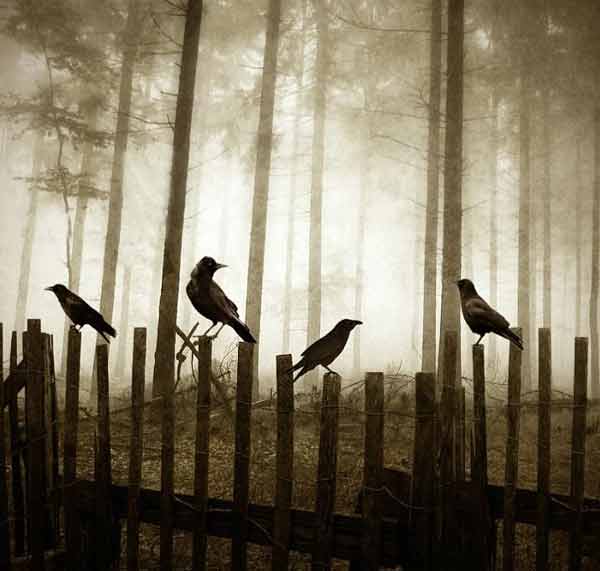
My concession to Halloween: "At the Edge of the Woods" by photographer D Siddlington
Research has shown that people can more easily learn a new language at a younger age. A new study extends this phenomenon to the language of marketing. In speed-of-recognition tests on college
students and senior citizens, researchers found that exposure to brand names at younger ages increased brand familiarity in the present. Even brand names that had been extinct for decades were recognised
more quickly among seniors than newer brands. According to the authors, "the current findings indicate that there should be a
considerable advantage to acquainting children with brand names, even if the products in question are ones they will not purchase or be interested in until later in life."
  Combining his carpentry skills with his love of nature, artist Patrick Dougherty experiments with tree
saplings as construction material. Beginning about 30 years ago with small works, he now requires sticks by the truckload. He's built over 200 massive sculptures all over the world. "Around
the Corner" is an installation at the University of Southern Indiana, New Harmony Gallery, done in 2003. It's shown in summer and in winter. Is it just me? How does cutting saplings by the
truckload demonstrate your love of nature? Just asking. Combining his carpentry skills with his love of nature, artist Patrick Dougherty experiments with tree
saplings as construction material. Beginning about 30 years ago with small works, he now requires sticks by the truckload. He's built over 200 massive sculptures all over the world. "Around
the Corner" is an installation at the University of Southern Indiana, New Harmony Gallery, done in 2003. It's shown in summer and in winter. Is it just me? How does cutting saplings by the
truckload demonstrate your love of nature? Just asking.
  
A moral being is one who is capable of reflecting on his past actions and their motives - of approving of some and disapproving of others.
- Charles Darwin

For other updates click "Home" (for the latest) or "Next" (for older) below
|
 Animals
Animals Animation
Animation Art of Playing Cards
Art of Playing Cards Drugs
Drugs Education
Education Environment
Environment Flying
Flying History
History Humour
Humour Immigration
Immigration Info/Tech
Info/Tech Intellectual/Entertaining
Intellectual/Entertaining Lifestyles
Lifestyles Men
Men Money/Politics/Law
Money/Politics/Law New Jersey
New Jersey Odds and Oddities
Odds and Oddities Older & Under
Older & Under Photography
Photography Prisons
Prisons Relationships
Relationships Science
Science Social/Cultural
Social/Cultural Terrorism
Terrorism Wellington
Wellington Working
Working Zero Return Investment
Zero Return Investment
































